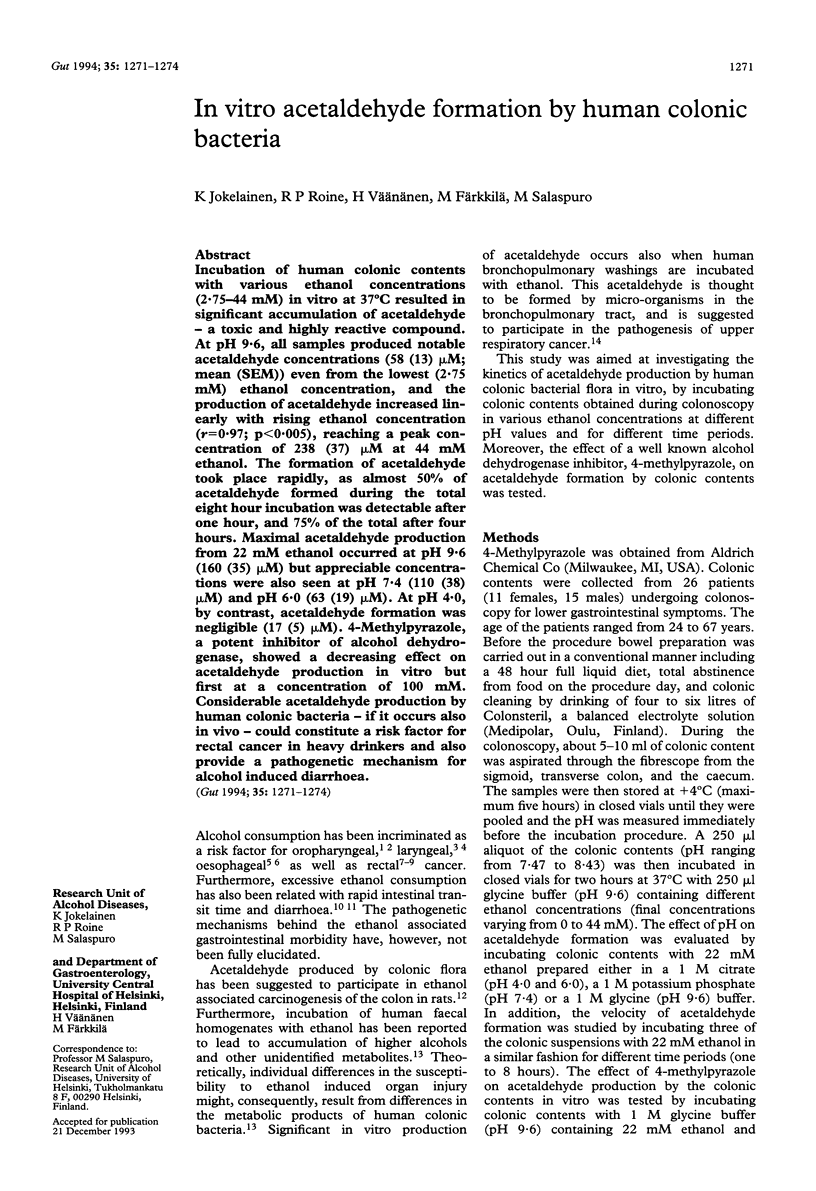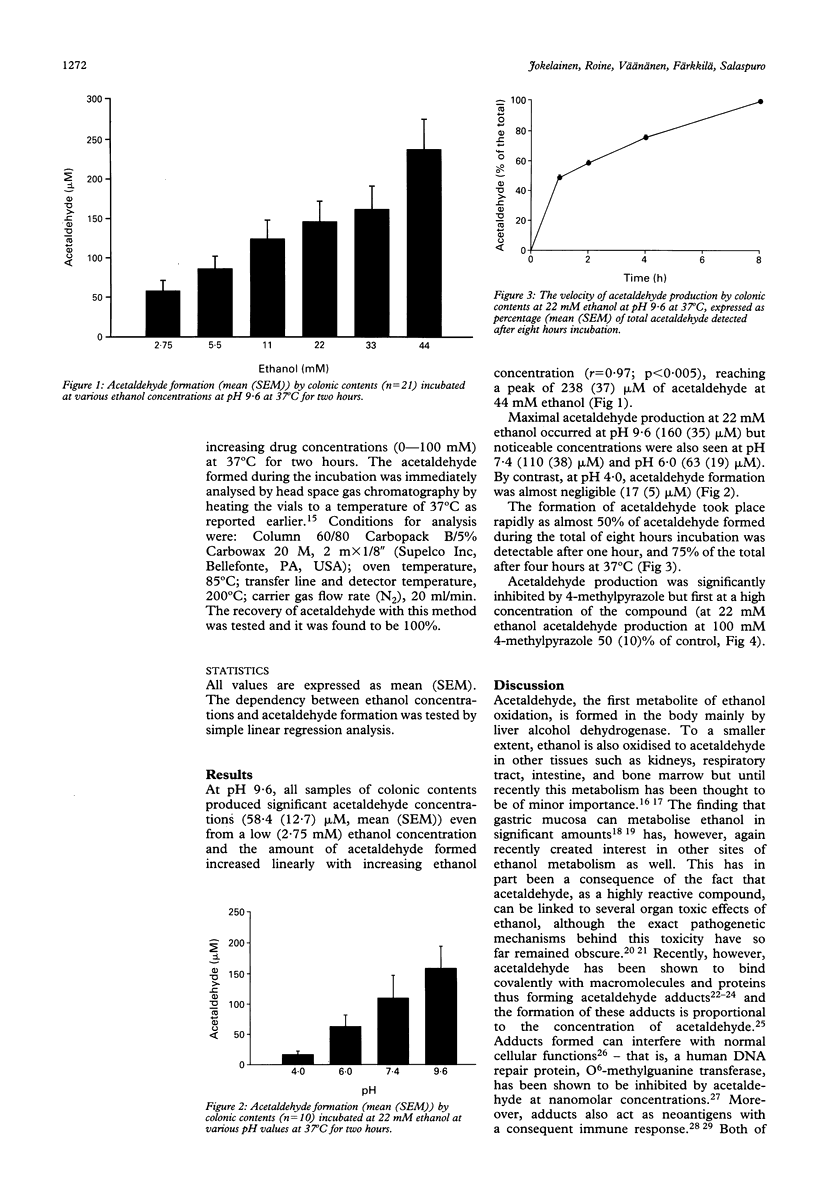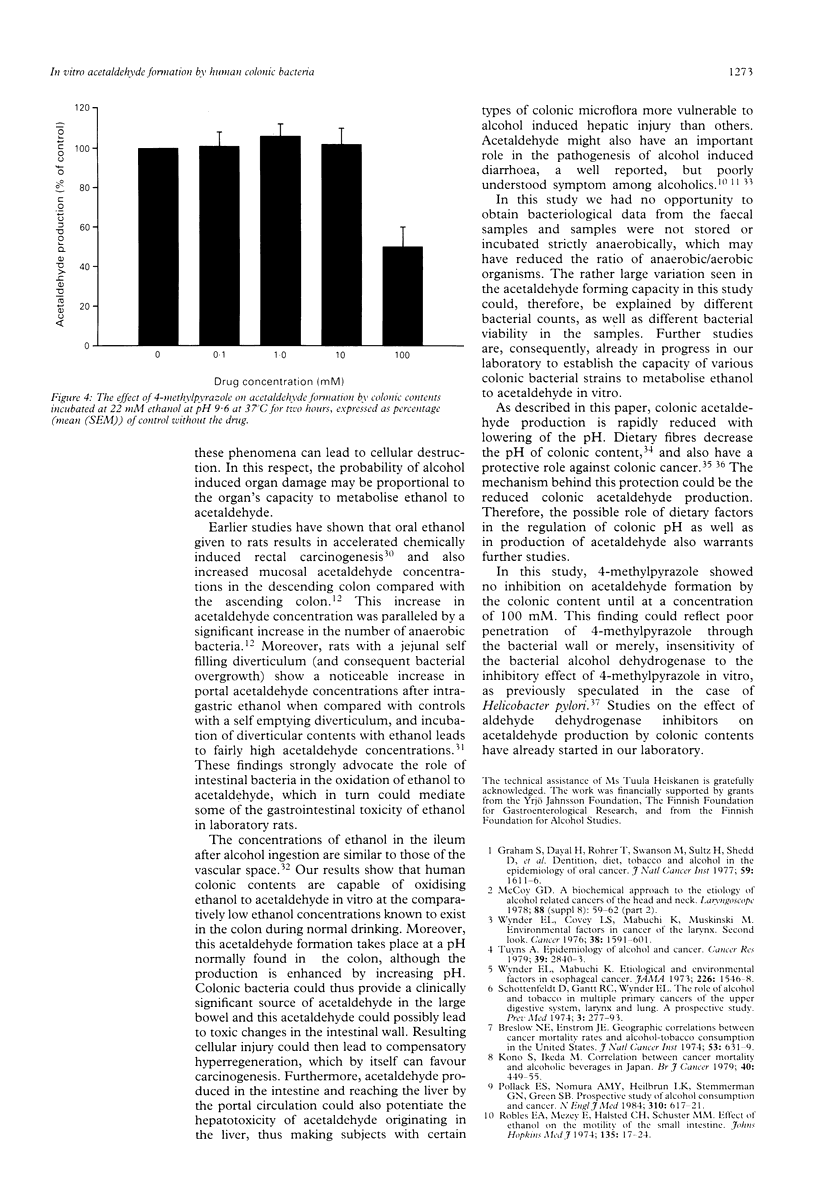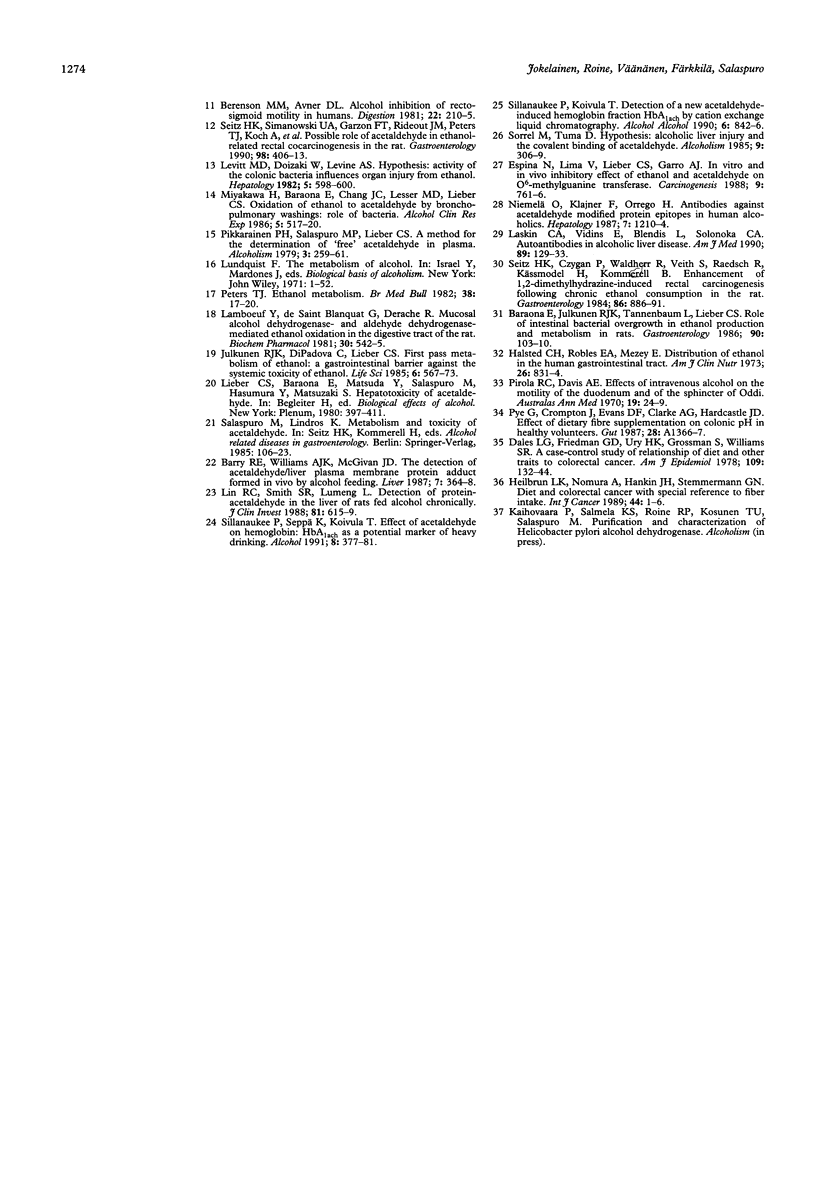Abstract
Incubation of human colonic contents with various ethanol concentrations (2.75-44 mM) in vitro at 37 degrees C resulted in significant accumulation of acetaldehyde--a toxic and highly reactive compound. At pH 9.6, all samples produced notable acetaldehyde concentrations (58 (13) microM; mean (SEM)) even from the lowest (2.75 mM) ethanol concentration, and the production of acetaldehyde increased lin-early with rising ethanol concentration (r = 0.97; p < 0.005), reaching a peak concentration of 238 (37) microM at 44 mM ethanol. The formation of acetaldehyde took place rapidly, as almost 50% of acetaldehyde formed during the total eight hour incubation was detectable after one hour, and 75% of the total after four hours. Maximal acetaldehyde production from 22 mM ethanol occurred at pH 9.6 (160 (35) microM) but appreciable concentrations were also seen at pH 7.4 (110 (38) microM) and pH 6.0 (63 (19) microM). At pH 4.0, by contrast, acetaldehyde formation was negligible (17 (5) microM). 4-Methylpyrazole, a potent inhibitor of alcohol dehydrogenase, showed a decreasing effect on acetaldehyde production in vitro but first at a concentration of 100 mM. Considerable acetaldehyde production by human colonic bacteria--if it occurs also in vivo--could constitute a risk factor for rectal cancer in heavy drinkers and also provide a pathogenetic mechanism for alcohol induced diarrhoea.
Full text
PDF



Selected References
These references are in PubMed. This may not be the complete list of references from this article.
- Baraona E., Julkunen R., Tannenbaum L., Lieber C. S. Role of intestinal bacterial overgrowth in ethanol production and metabolism in rats. Gastroenterology. 1986 Jan;90(1):103–110. doi: 10.1016/0016-5085(86)90081-8. [DOI] [PubMed] [Google Scholar]
- Barry R. E., Williams A. J., McGivan J. D. The detection of acetaldehyde/liver plasma membrane protein adduct formed in vivo by alcohol feeding. Liver. 1987 Dec;7(6):364–368. doi: 10.1111/j.1600-0676.1987.tb00368.x. [DOI] [PubMed] [Google Scholar]
- Berenson M. M., Avner D. L. Alcohol inhibition of rectosigmoid motility in humans. Digestion. 1981;22(4):210–215. doi: 10.1159/000198647. [DOI] [PubMed] [Google Scholar]
- Dales L. G., Friedman G. D., Ury H. K., Grossman S., Williams S. R. A case-control study of relationships of diet and other traits to colorectal cancer in American blacks. Am J Epidemiol. 1979 Feb;109(2):132–144. doi: 10.1093/oxfordjournals.aje.a112668. [DOI] [PubMed] [Google Scholar]
- Espina N., Lima V., Lieber C. S., Garro A. J. In vitro and in vivo inhibitory effect of ethanol and acetaldehyde on O6-methylguanine transferase. Carcinogenesis. 1988 May;9(5):761–766. doi: 10.1093/carcin/9.5.761. [DOI] [PubMed] [Google Scholar]
- Graham S., Dayal H., Rohrer T., Swanson M., Sultz H., Shedd D., Fischman S. Dentition, diet, tobacco, and alcohol in the epidemiology of oral cancer. J Natl Cancer Inst. 1977 Dec;59(6):1611–1618. doi: 10.1093/jnci/59.6.1611. [DOI] [PubMed] [Google Scholar]
- Halsted C. H., Robles E. A., Mezey E. Distribution of ethanol in the human gastrointestinal tract. Am J Clin Nutr. 1973 Aug;26(8):831–834. doi: 10.1093/ajcn/26.8.831. [DOI] [PubMed] [Google Scholar]
- Heilbrun L. K., Nomura A., Hankin J. H., Stemmermann G. N. Diet and colorectal cancer with special reference to fiber intake. Int J Cancer. 1989 Jul 15;44(1):1–6. doi: 10.1002/ijc.2910440102. [DOI] [PubMed] [Google Scholar]
- Julkunen R. J., Di Padova C., Lieber C. S. First pass metabolism of ethanol--a gastrointestinal barrier against the systemic toxicity of ethanol. Life Sci. 1985 Aug 12;37(6):567–573. doi: 10.1016/0024-3205(85)90470-9. [DOI] [PubMed] [Google Scholar]
- Kono S., Ikeda M. Correlation between cancer mortality and alcoholic beverage in Japan. Br J Cancer. 1979 Sep;40(3):449–455. doi: 10.1038/bjc.1979.200. [DOI] [PMC free article] [PubMed] [Google Scholar]
- Lamboeuf Y., de Saint Blanquat G., Derache R. Mucosal alcohol dehydrogenase- and aldehyde dehydrogenase-mediated ethanol oxidation in the digestive tract of the rat. Biochem Pharmacol. 1981 Mar 1;30(5):542–545. doi: 10.1016/0006-2952(81)90643-2. [DOI] [PubMed] [Google Scholar]
- Laskin C. A., Vidins E., Blendis L. M., Soloninka C. A. Autoantibodies in alcoholic liver disease. Am J Med. 1990 Aug;89(2):129–133. doi: 10.1016/0002-9343(90)90288-o. [DOI] [PubMed] [Google Scholar]
- Levitt M. D., Doizaki W., Levine A. S. Hypothesis: metabolic activity of the colonic bacteria influences organ injury from ethanol. Hepatology. 1982 Sep-Oct;2(5):598–600. doi: 10.1002/hep.1840020514. [DOI] [PubMed] [Google Scholar]
- Lieber C. S., Baraona E., Matsuda Y., Salaspuro M., Hasumura Y., Matsuzaki S. Hepatotoxicity of acetaldehyde. Adv Exp Med Biol. 1980;126:397–411. doi: 10.1007/978-1-4684-3632-7_29. [DOI] [PubMed] [Google Scholar]
- Lin R. C., Smith R. S., Lumeng L. Detection of a protein-acetaldehyde adduct in the liver of rats fed alcohol chronically. J Clin Invest. 1988 Feb;81(2):615–619. doi: 10.1172/JCI113362. [DOI] [PMC free article] [PubMed] [Google Scholar]
- McCoy G. D. A biochemical approach to the etiology of alcohol related cancers of the head and neck. Laryngoscope. 1978 Jan;88(1 Pt 2 Suppl 8):59–62. [PubMed] [Google Scholar]
- Miyakawa H., Baraona E., Chang J. C., Lesser M. D., Lieber C. S. Oxidation of ethanol to acetaldehyde by bronchopulmonary washings: role of bacteria. Alcohol Clin Exp Res. 1986 Oct;10(5):517–520. doi: 10.1111/j.1530-0277.1986.tb05134.x. [DOI] [PubMed] [Google Scholar]
- Niemelä O., Klajner F., Orrego H., Vidins E., Blendis L., Israel Y. Antibodies against acetaldehyde-modified protein epitopes in human alcoholics. Hepatology. 1987 Nov-Dec;7(6):1210–1214. doi: 10.1002/hep.1840070607. [DOI] [PubMed] [Google Scholar]
- Peters T. J. Ethanol metabolism. Br Med Bull. 1982 Jan;38(1):17–20. doi: 10.1093/oxfordjournals.bmb.a071726. [DOI] [PubMed] [Google Scholar]
- Pikkarainen P. H., Salaspuro M. P., Lieber C. S. A method for the determination of "free" acetaldehyde in plasma. Alcohol Clin Exp Res. 1979 Jul;3(3):259–261. doi: 10.1111/j.1530-0277.1979.tb05311.x. [DOI] [PubMed] [Google Scholar]
- Pirola R. C., Davis A. E. Effects of intravenous alcohol on motility of the duodenum and of the sphincter of Oddi. Australas Ann Med. 1970 Feb;19(1):24–29. doi: 10.1111/imj.1970.19.1.24. [DOI] [PubMed] [Google Scholar]
- Pollack E. S., Nomura A. M., Heilbrun L. K., Stemmermann G. N., Green S. B. Prospective study of alcohol consumption and cancer. N Engl J Med. 1984 Mar 8;310(10):617–621. doi: 10.1056/NEJM198403083101003. [DOI] [PubMed] [Google Scholar]
- Schottenfeld D., Gantt R. C., Wyner E. L. The role of alcohol and tobacco in multiple primary cancers of the upper digestive system, larynx and lung: a prospective study. Prev Med. 1974 Jun;3(2):277–293. doi: 10.1016/0091-7435(74)90037-1. [DOI] [PubMed] [Google Scholar]
- Seitz H. K., Czygan P., Waldherr R., Veith S., Raedsch R., Kässmodel H., Kommerell B. Enhancement of 1,2-dimethylhydrazine-induced rectal carcinogenesis following chronic ethanol consumption in the rat. Gastroenterology. 1984 May;86(5 Pt 1):886–891. [PubMed] [Google Scholar]
- Seitz H. K., Simanowski U. A., Garzon F. T., Rideout J. M., Peters T. J., Koch A., Berger M. R., Einecke H., Maiwald M. Possible role of acetaldehyde in ethanol-related rectal cocarcinogenesis in the rat. Gastroenterology. 1990 Feb;98(2):406–413. doi: 10.1016/0016-5085(90)90832-l. [DOI] [PubMed] [Google Scholar]
- Sillanaukee P., Koivula T. Detection of a new acetaldehyde-induced hemoglobin fraction HbA1ach by cation exchange liquid chromatography. Alcohol Clin Exp Res. 1990 Dec;14(6):842–846. doi: 10.1111/j.1530-0277.1990.tb01825.x. [DOI] [PubMed] [Google Scholar]
- Sillanaukee P., Seppä K., Koivula T. Effect of acetaldehyde on hemoglobin: HbA1ach as a potential marker of heavy drinking. Alcohol. 1991 Sep-Oct;8(5):377–381. doi: 10.1016/0741-8329(91)90603-t. [DOI] [PubMed] [Google Scholar]
- Sorrell M. F., Tuma D. J. Hypothesis: alcoholic liver injury and the covalent binding of acetaldehyde. Alcohol Clin Exp Res. 1985 Jul-Aug;9(4):306–309. doi: 10.1111/j.1530-0277.1985.tb05549.x. [DOI] [PubMed] [Google Scholar]
- Tuyns A. J. Epidemiology of alcohol and cancer. Cancer Res. 1979 Jul;39(7 Pt 2):2840–2843. [PubMed] [Google Scholar]
- Wynder E. L., Covey L. S., Mabuchi K., Mushinski M. Environmental factors in cancer of the larynx: a second look. Cancer. 1976 Oct;38(4):1591–1601. doi: 10.1002/1097-0142(197610)38:4<1591::aid-cncr2820380425>3.0.co;2-r. [DOI] [PubMed] [Google Scholar]
- Wynder E. L., Mabuchi K. Cancer of the gastrointestinal tract. Etiological and environmental factors. JAMA. 1973 Dec 24;226(13):1546–1548. doi: 10.1001/jama.226.13.1546. [DOI] [PubMed] [Google Scholar]


